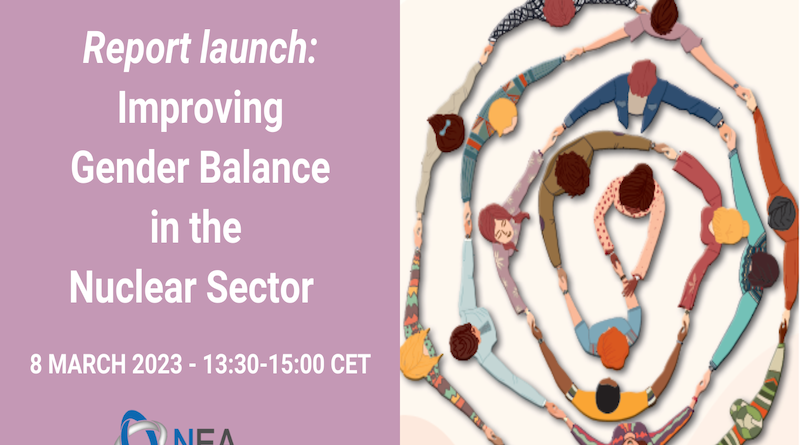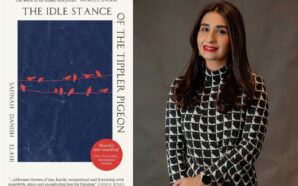March 8th, 2023: NEA analyses highlight that total nuclear energy production needs to triple by 2050 for governments around the world to achieve net zero emissions. The nuclear sector will need to grow and diversify its workforce as a result, but that will be difficult to achieve unless it attracts more women.
A new NEA report reveals that nearly half the women surveyed in the nuclear energy sector have experienced or heard accounts of gender bias and sexual harassment at work. The publication also highlights that women are paid less* and feel as though they lack female role models, which makes it harder for the sector to attract more female talent.
The report Gender Balance in the Nuclear Sector is based on data collected from over 8,000 women in the nuclear workforce in 32 countries, as well as human resources data from 96 nuclear organisations in 17 countries. It is the first publicly available international data on gender balance in the nuclear sector.
The report found that women in the nuclear sector are eager to advance but face challenges such as a lack of flexible work practices for those with family responsibilities, as well as gender stereotyping. The current recruitment, attrition and promotion rates are insufficient to significantly improve gender balance in the sector.
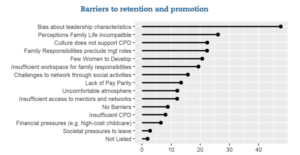
Graphic_Barriers to career progression
Women such as Marie Skłodowska-Curie, Lisa Meitner, Chien-Shiung Wu and Katharine Way were key pioneers in nuclear science and technology and women around the world continue to make vital contributions. But as this report reveals, their visibility and numbers – only 24.9% of the nuclear sector workforce in NEA countries is female – remain low. The number of women in the sector in who serve in science, technology, engineering and mathematics (STEM) and leadership roles are lower still. This lack of diversity represents a loss of potential innovation and growth and a critical threat to the viability of the field.
Despite the challenges, the majority of women surveyed said that they would encourage other women to pursue a career in the nuclear sector, which offers hope for the sector as it seeks to attract and retain more female talent to meet its ambitious future targets.
William D. Magwood, IV, Director-General of the Nuclear Energy Agency, said:
“Our member countries, whatever their policies with regard to nuclear energy, need a large number of talented, well-trained people to address the challenges of the future. The fact that so few women enter nuclear science and technology fields and fewer still climb to leadership roles is a terrible loss of a resource that is desperately needed. Beyond that, I believe all activities benefit from having diverse viewpoints brought together to analyse and solve challenges. Women often bring a different perspective that I find enhances organisations and strengthens outcomes. The lack of women in the nuclear field, in my view, is an existential challenge for the sector.”
Dr Fiona Rayment, Chief Science and Technology Officer of the United Kingdom National Nuclear Laboratory and Chair of the NEA Task Group that conducted the study, said:
“With the ever-increasing importance of energy security while minimising carbon emissions, a solution including nuclear energy is receiving greater focus. Meeting these challenges requires a broad range of skills that can be delivered through a neuro-diverse workforce, and creating gender balance across the international nuclear sector is a key element in achieving this. I am delighted to see the launch of this report which provides the quantitative and qualitative information on the status of gender balance in nuclear internationally and the associated challenges that women face. My hope is that this report enables the sector to have a springboard to move to greater gender balance in the years ahead driving the neurodiversity the sector is craving.”

Female participation graphic
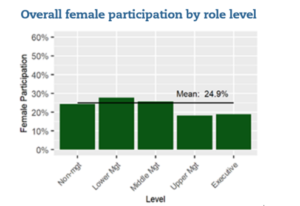
Female participation by role
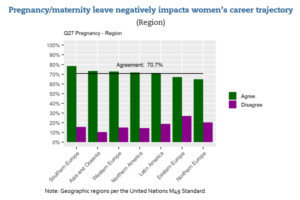
Impacts of pregnancy and maternity leave on career
Women in the nuclear sector in NEA countries are:
- 24.9% of the nuclear workforce surveyed in 96 organisations in 17 countries;
- Poorly represented in upper management and executive levels, with both under 20%;
- Paid on average 5.2% less than men (based on limited data from 12 countries), with some countries showing far greater disparities;
- Nearly half of women surveyed have experienced, or heard of a female colleague experiencing, hostility in their nuclear workplace, including sexual harassment;
- Women rank improving the visibility of women in the sector, including in STEM and leadership roles, as a solution for enhancing the attractiveness of the sector for women;
- Increasing career flexibility and developing solutions to balance professional and family responsibilities poll strongly as ways to increase the sector’s gender balance;
- Most women surveyed would encourage other women to pursue a career in the sector.
Download the report: oecd-nea.org/gender-balance
The OECD Nuclear Energy Agency (NEA) is an intergovernmental agency that facilitates co-operation among countries with advanced nuclear technology infrastructures to seek excellence in nuclear safety, technology, science, environment and law. The NEA operates within the framework of the Organisation for Economic Co-operation and Development (OECD) and is located just outside Paris, France. The objective of the Agency is to assist its member countries in maintaining and further developing, through international co-operation, the scientific, technological and legal bases required for a safe, environmentally sound and economical use of nuclear energy for peaceful purposes.
*Based on limited datasets.
Content credits: NEA (2023), Gender Balance in the Nuclear Sector, OECD Publishing, Paris




